Start date 1982 | ||
 | ||
Operation black buck
During the 1982 Falklands War, Operations Black Buck 1 to Black Buck 7 were a series of seven extremely long-range ground attack missions by Royal Air Force Vulcan bombers of the RAF Waddington Wing, comprising aircraft from 44 Squadron, 50 Squadron, 101 Squadron planned against Argentine positions in the Falkland Islands, of which five missions actually completed attacks on the Falklands. The objectives of all missions were to attack Port Stanley airfield and its associated defences.
Contents
- Operation black buck
- Fsx movie operation black buck hd
- Background
- Black Buck One
- Black Buck Two
- Black Buck Three
- Black Buck Four
- Black Buck Five
- Black Buck Six
- Black Buck Seven
- Effect
- References
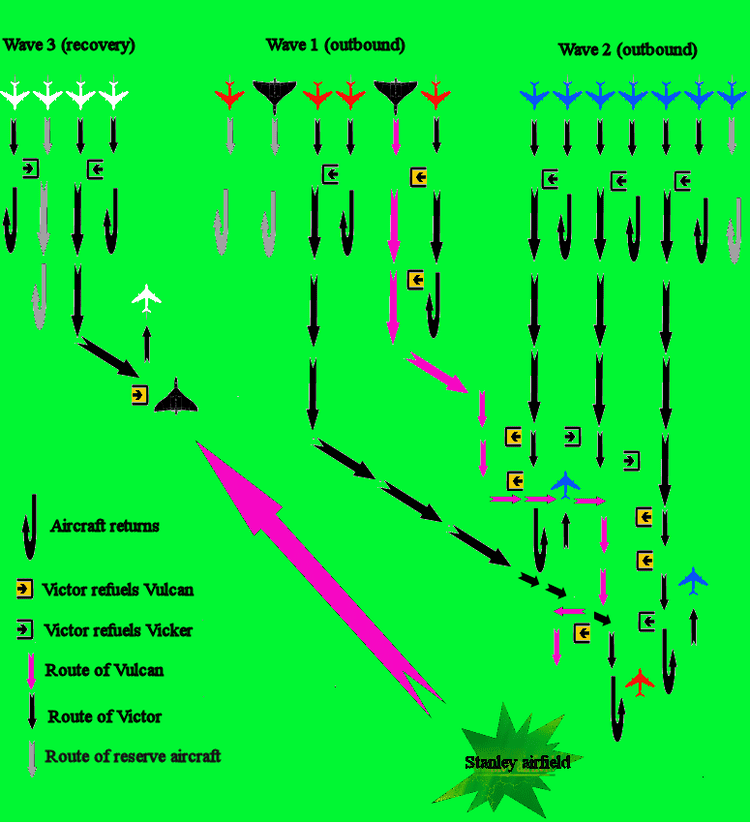
The Operation Black Buck raids were staged from RAF Ascension Island, close to the equator. The aircraft carried either twenty-one 1,000 lb bombs internally or two or four Shrike anti-radar missiles externally. The overall effect of the raids on the war is difficult to determine. The raids did minimal damage to the runway and damage to radars was quickly repaired. Commonly dismissed as post-war propaganda, Argentine sources originally claimed that the Vulcan raids influenced Argentina to withdraw some of their Dassault Mirage III fighter aircraft from the Southern Argentina Defence Zone to the Buenos Aires Defence Zone. This dissuasive effect was however watered down when British officials made clear that there would be no strikes on air bases in Argentina. It has been suggested that the Black Buck raids were pressed home by the Royal Air Force because the British armed forces had been cut in the late seventies and the RAF may have desired a greater role in the conflict to prevent further cuts.
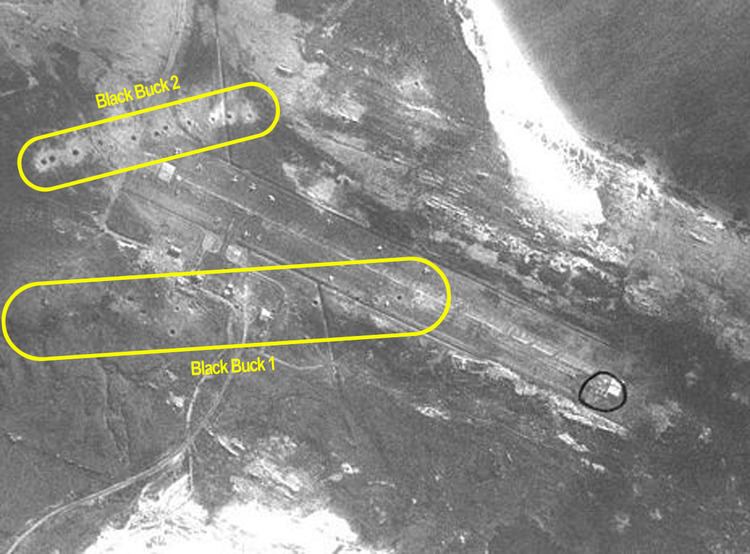
A single crater was produced on the runway, rendering it impossible for the airfield to be used by fast jets. Argentine ground crew repaired the runway within twenty-four hours, to a level of quality suitable for the C-130 Hercules transport and Aermacchi MB-339 light attack jet. Many sources claim that fake craters confounded British damage assessment; however, the British were well aware that the runway remained in use by C-130 military transport aircraft and IA 58 Pucará ground-attack aircraft.
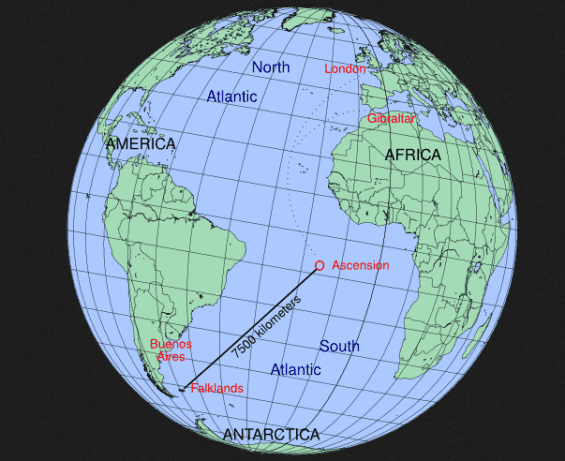
The Vulcan lacked the range to fly to the Falklands without refuelling several times, as it had been designed for medium-range stand-off nuclear missions in Europe. The RAF's tanker planes were mostly converted Handley Page Victor bombers with similar range, so they too had to be refuelled in the air. A total of 11 tankers were required for two Vulcans, a huge logistical effort as all aircraft had to use the same strip.
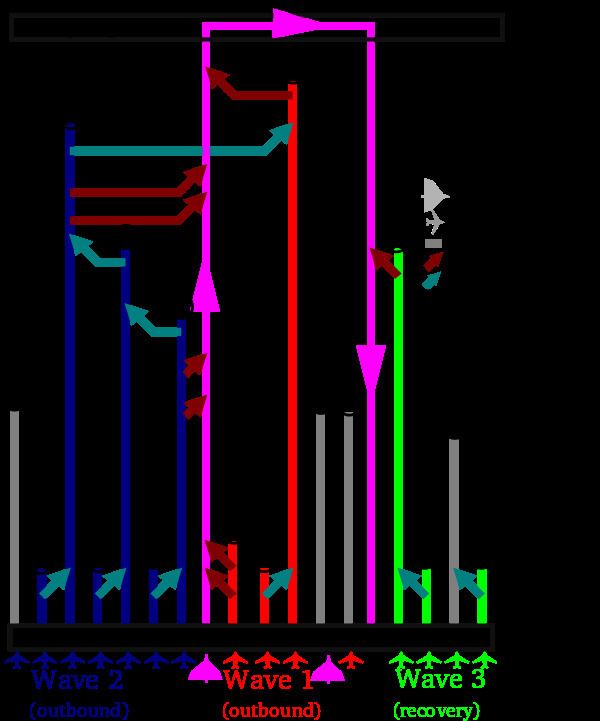
The raids, at almost 6,800 nautical miles (12,600 km) and 16 hours for the return journey, were the longest-ranged bombing raids in history at that time (surpassed in the Gulf War of 1991 by USAF Boeing B-52G Stratofortresses flying from the continental United States but using forward-positioned tankers).
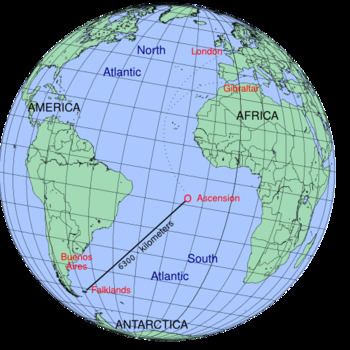
Of the five Black Buck raids flown to completion, three were against Stanley Airfield's runway and operational facilities, and the other two were anti-radar missions using Shrike anti-radiation missiles against defences in the Port Stanley area.

Fsx movie operation black buck hd
Background
Without aircraft able to cover the long distance, activities in the South Atlantic would be carried out by the Royal Navy and the British Army. Plans were set in motion within the RAF to see if it could carry out any operations near the Falklands. The airfield nearest to the Falklands and usable for RAF operations was on Ascension Island, a British territory, with a single runway at Wideawake airfield which was leased to the US.
Long-range operations were entirely dependent upon the RAF's tanker fleet and so fourteen Handley Page Victor tankers were transferred from RAF Marham to Ascension Island. The RAF tankers themselves were capable of being refuelled in flight, which meant that it was possible to set up relays of aircraft. At RAF Marham, the tanker force was set to planning refuelling operations to take one or more bombers to the Falklands and back. Initial long range operations by the RAF involved the use of Victor aircraft for photo reconnaissance of the region surrounding South Georgia; these missions demonstrated the capability of the Victor tanker fleet, flying out of Ascension, to support intelligence gathering and aggressive operations in the south Atlantic.
The Avro Vulcan was the last of the British V bombers in operational use for bombing, but their squadrons were to be disbanded imminently. They were based in the UK and assigned to NATO for nuclear operations: neither air-to-air refuelling nor conventional bombing had been practised for several years.
At RAF Waddington, the retraining of crews in conventional bombing and in-flight refuelling was begun. Aircraft were selected based upon their engines; only those with the more powerful Bristol Olympus 301 engines were considered suitable. One of the most challenging tasks was re-instating the refuelling system, which had been blocked off.
Three 22-year-old Vulcan B2s were selected—XM597, XM598 and XM607—drawn from No. 44, 50 and No. 101 Squadron RAF. After an initial delay of one day, the Vulcans were deployed to Wideawake, arriving on 28 April. Two further Vulcans, XM612 and XL391 were stationed at Wideawake as reserve aircraft in case of mechanical failures in the three primary aircraft. Squadron Leader Neil McDougall, Squadron Leader John Reeve, Squadron Leader Alastair 'Monty' Montgomery and Flight Lieutenant Martin Withers captained the Vulcans.
To give improved electronic countermeasures (ECM) against Argentine defences, which were known to include Tigercat missile and radar-controlled anti-aircraft guns, Dash 10 pods from Blackburn Buccaneer aircraft at RAF Honington were fitted to the wings of the Vulcans on improvised pylons. Evaluation of the effectiveness of the Dash 10 pod and ECM training was undertaken at the RAF Spadeadam electronic warfare ranges in north-west England. To navigate across the featureless seas, inertial guidance systems were borrowed from VC-10s and two installed in each Vulcan.
The Vulcan fuel tanks could contain 9,200 gal (41,823 litres). Based upon estimates of the Vulcan's fuel need, eleven Victor tankers, including two reserve aircraft, were assigned to refuel the single Vulcan before and after its attack on the Falklands. The attacking Vulcan was refuelled four times on the outward journey and once on the return journey, using over 220,000 gallons of aviation fuel during the mission. Two identically-armed Vulcans took off for each mission, the second returning to base, without refuelling, if no problems arose with the first, or assuming its role if the first could not continue. Each aircraft carried either twenty-one 1,000-pound (450 kg) bombs or four Shrike anti-radar missiles (Dash 10 pod) with three 1,000 gallon (4,546 litres) auxiliary fuel tanks in the bomb bay. The bombs were intended to cause damage to Argentine installations, especially Port Stanley Airport; it being hoped that the attacks would cause the defenders to switch on defensive radars, which would then be targeted by the missiles. The lighter Shrike-armed Vulcans could loiter in the area longer than the bomb-armed Vulcans. Fleet Air Arm officer and critic of the RAF, Nigel Ward unfavourably compared the amount of fuel consumed by the raids to that used in Sea Harrier bombing missions.
Black Buck One
The first surprise attack on the islands, on 30 April/1 May was aimed at the main runway at Port Stanley Airport. Carrying twenty-one 1,000 pounds (450 kg) general-purpose bombs, the bomber was to fly across the line of the runway at about 35 degrees. The bomb release system was timed to drop sequentially from 10,000 feet (3,000 m) so that at least one bomb would hit the runway.
For the mission, two Vulcans took off from RAF Ascension Island; XM598 was the lead with XM607 as the reserve. Shortly after take off, XM598, commanded by Squadron Leader John Reeve, suffered a pressurisation failure (a rubber seal on the "Direct Vision" side window had perished) and was forced to return to Ascension. XM607, captained by Flight Lieutenant Martin Withers, took over.
As well as XM598, one of the Victor tankers returned to Ascension with a faulty refuelling hose system and its place was taken by a reserve.
The Vulcan was over its normal maximum take-off weight—each carried, as well as extra equipment like the DASH 10 and a chemical toilet, a highly experienced Air to Air Refuelling Instructor (AARI) from the Victor tanker force who would fly the Vulcan during refuelling—and fuel usage was higher than expected. As a result of the fuel demand and problems in flight with refuelling, two of the Victors had to fly further south than planned, eating into their own reserves. At the Victor's final refuelling bracket, the sortie flew into a violent thunderstorm, during which the receiver aircraft's refuelling probe failed, forcing the provider aircraft to swap places and take back the fuel. XL189 the last Victor to refuel the Vulcan, was past the last refuelling bracket before turning home. Tankers had to be sent south to refuel these Victors so they could reach Ascension. A total of 11 Victors were used to support Black Buck One: XH669, XH672, XL162, XL163, XL188, XL189, XL192, XL232, XL511, XL512 and XM717.
XM607 made the final approach at around 300 ft above the sea. Before climbing to attack height the H2S radar was successfully locked on to offset markers on the coast and bombing handed over to the control system. The attack was delivered around 4 am local time.
XM607 then climbed away from the airfield and headed nearly due north to a planned rendezvous with a Victor some way off the coast of Rio de Janeiro. As it passed the British Task Force it signalled the code word "superfuse" indicating a successful attack. Its journey continued up within range of the South American coast to its rendezvous with a tanker. After contacting control with an update, the tanker was sent further south. To help bring the two planes together a Nimrod Maritime Reconnaissance aircraft was flown from Wideawake to the area. Without an in-flight refuelling system it was unable to loiter long. XM607 made the link and was able to return to Ascension.
Northwood received the "superfuse" message by 8:30 and the MoD shortly thereafter. The news of the bombing raid was reported on the BBC World Service before either the Vulcan or the last tanker arrived back at Ascension.
The stick of twenty-one 1000 lb bombs crossed the airfield, damaged the airport tower, scored a single direct hit in the centre of the runway and killed two Air Force personnel. However, it still remained operational for the Argentine C-130 Hercules transports. The bombs falling on either side of the runway caused slight damage to tented installations in the airfield perimeter. This was due to the careful dispersal of equipment by the base Commander.
The attack took the Argentines (as well as the rest of the world) completely by surprise. Black Buck One was the first operation undertaken as part of the United Kingdom's Task Force's first strategic objective in pursuit of its overall objective of liberating the Falkland Islands, namely, attaining air superiority over the Falklands and surrounding airspace. The Black Buck One attack was aimed at degrading the Argentine's capability to use the airfield at Port Stanley and was followed on the same day by bombing attacks by Sea Harriers from HMS Hermes and by naval bombardment from HMS Glamorgan, HMS Alacrity, and HMS Arrow. This strategy also saw the airfield at Goose Green attacked on the same day by Sea Harriers.
Flight Lieutenant Withers was awarded the Distinguished Flying Cross for his part in the action and his crew were Mentioned in Dispatches. Squadron Leader Bob Tuxford, who had piloted Victor XL189, the last Victor to refuel XM607, received the Air Force Cross.
Black Buck Two
During the night of 3/4 May, XM607 (flown by Squadron Leader John Reeve and his crew of No 50 Squadron) flew a near identical mission to the first. XM598 acted as flying reserve aircraft, piloted by Squadron Leader Alastair Montgomery. As with Black Buck One the approach to Port Stanley over the final 200 miles was made at ultra low altitude with the final 'pop-up' to a higher altitude, 16,000 feet, for the bomb run in order to avoid the, now fully alert, Argentine anti-aircraft defences. This raid targeted the area at the western end of the runway. According to RAF and White's book this was intended to prevent Argentine engineers from extending the runway sufficiently to make it capable of accommodating high performance combat aircraft. However, according to the historian Lawrence Freedman BB2 missed the runway because of the presence of Argentine Roland SAM. Two Argentine soldiers were wounded according to Argentine sources, which also confirm impacts near the western end of the airstrip.
Black Buck Three
This mission, scheduled for 13 May, was scrubbed before take-off due to strong headwinds. Vulcans XM612 and XM607.
Black Buck Four
This mission with XM597, scheduled for 28 May, was also scrubbed, but only some 5 hours after the Vulcan had taken off. One of the supporting Victor aircraft, which were flying refuelling operations, suffered a failure of the hose-and-drogue refuelling unit, and the flight had to be recalled. XM598 acted as flying reserve aircraft.
The mission had been due to be the first using American supplied AGM-45 Shrike Anti-Radar missiles, which were mounted on the Vulcans using improvised underwing pylons.
Black Buck Five
This mission, flown by Squadron Leader Neil McDougall and his crew from 50 Squadron in XM597, on 31 May, was the first completed anti-radar mission equipped with AGM-45A Shrike missiles. The main target was a Westinghouse AN/TPS-43 long range 3D radar that the Argentine Air Force deployed during April to guard the airspace surrounding the Falklands. An attack could only succeed if the targeted radar continued transmitting until struck. At 08:45Z two Shrikes were launched at it. The first missile impacted 10 metres away from the target, causing minor blast damage to the wave-guide assembly, but not disabling the radar. The Argentine operators then turned their radar off, preventing further damage. The AN/TPS-43 radar remained operational during the rest of the conflict. XM598 acted as flying reserve aircraft, again piloted by Squadron Leader Alastair Montgomery.
Black Buck Six
This mission, again flown by Squadron Leader Neil McDougall in XM597, was now armed with four missiles instead of two. Black Buck Six loitered for 40 minutes in a vain effort to engage the unswitched AN/TPS-43. Finally they fired two Shrikes and destroyed a Skyguard fire-control radar of the army's 601 Anti-Aircraft Battalion on 3 June, killing four radar operators - an officer, a sergeant and two privates. On its return flight the aircraft was forced to divert to Rio de Janeiro in Brazil after its in-flight refuelling probe broke. One of the missiles it was carrying was ditched into the ocean to reduce drag, but the other remained stuck on the pylon and could not be released. Sensitive documents containing classified information were jettisoned into the sea via the crew hatch, and a "Mayday" signal was sent. The aircraft was cleared to land by Brazilian authorities with less than 2,000 lbs of fuel remaining, not enough to complete a circuit of the airport.
The aircraft was interned for nine days at Galeão Air Force Base, then the crew and aircraft were returned on 11 June, having been treated well by the authorities. However, the remaining Shrike missile was confiscated and never returned, and the Brazilian authorities returned the aircraft on condition that it would take no further part in the Falklands War. XM598 acted as flying reserve aircraft, flown once again by Squadron Leader Alastair Montgomery.
Black Buck Seven
The final Black Buck mission (XM607 flown by Flight Lieutenant Martin Withers) was against Argentine troop positions close to Stanley on 12 June, cratering the eastern end of the airfield and causing widespread damage to airfield stores and facilities. The bombs were fuzed in error to explode on impact; the end of the war was in sight and the intention had been for them to explode in mid-air to destroy aircraft and stores without damaging the runway, which would be needed for RAF Phantom FGR.2 operations after the Falkland Islands were recaptured. The Argentine ground forces surrendered two days later. XM598 acted as flying reserve aircraft, piloted by Squadron Leader Alastair Montgomery.
Effect
The military effectiveness of Black Buck remains controversial to this day with some independent sources describing it as minimal, the damage to the airfield and radars being quickly repaired. The runway continued to be used by Argentine C-130s until the end of the war and was also available for Aermacchi MB-339 jets and FMA Pucarás. As a result of the controversy a number of common misconceptions exist about the raid.
Although commonly dismissed as British propaganda, Argentine sources confirm claims that Black Buck was initially responsible for the withdrawal of a number of Mirage IIIEA from operations over the islands in order to protect the mainland. This dissuasive effect was however watered down when British officials made clear that there would not be strikes on air bases in Argentina.
There are urban legends that claim Argentine engineers building the runway plotted its position incorrectly on maps, leading to the British missing the runway. The runway at Port Stanley was in fact built by British engineers, replacing an earlier temporary strip constructed by LADE in the early 1970s.
The purposes of the raid and its effect on the runway are also commonly misunderstood. British air power doctrine recognises that attacks against the operating surfaces of runways can have limited effect. Planning for the raid called for a bomb run in a 35° cut across the runway, with the aim of placing at least one bomb on the runway and possibly two. The main purpose in doing so was to prevent the use of the runway by fast jets; in this respect the raid was successful as the repair to the runway was botched and subsequently there were several near accidents. The fact that the British forces could penetrate Argentine air defences and attack the airfield had the desired effect in relation to preventing fast jet usage of the Port Stanley airstrip as the Argentine military command could not risk stationing its fast jets and the infrastructure necessary to operate them on the Islands if they could be destroyed on the ground, irrespective of the operational status of the runway. It was realised at the time that the runway would likely remain open to use by C-130s; the RAF routinely practices rough field take offs in their C-130s.
The Argentines left the runway covered with piles of earth during the day, leading to claims this caused British intelligence to surmise that repairs were still in progress and misleading the British as to the condition of the airfield and the success of their raids. In fact, the British were well aware that C-130 flights continued to use the airfield and attempted to interdict these flights leading to the loss of a C-130 on 1 June, which was not, however, engaged in any resupply mission.
Another common misconception is that the Argentine forces made no attempt to use the airfield at Port Stanley as a base for high-performance jets. In early April the Argentine Naval Aviation installed arrestor gear on the runway to enable short landings, and A-4Q Skyhawks of 3 Escuadrilla and S-2 Trackers (2-AS-22, 2-AS-25) deployed to the airfield performing several reconnaissance missions until April 13 when they were redeployed to the continent to embark on ARA Veinticinco de Mayo. After the carrier returned to port, and due to the continuous naval bombardment of Stanley, the aircraft operated from Rio Grande, Tierra del Fuego and Río Gallegos, Santa Cruz respectively. Engineers of the Argentine Air Force had added additional steel matting to extend the parking area for the Pucaras and Aermacchis that used the airfield, but the main equipment to extend the runway was still on the ELMA cargo ship Cordoba which could not cross to the island due to the British submarine threat.
To the British, the raids achieved a number of non-material objectives in addition to the physical damage caused. These included demonstrating their willingness to defend British territories from forceful invasion, signalling British intent to recapture the Falklands, showing Britain's ability to attack Argentine forces on the islands, and showing that the British air power that could be deployed in support of the Task force was not limited to aircraft flying from Task Force ships. It also demonstrated the possibility of escalating the conflict in future by striking industrial and military targets on the Argentinian mainland. Regardless of whether or not the British actually intended to pursue these options and escalate the conflict, the Argentinian leadership would have been fully aware of the implications.
According to Rowland White, the author of Vulcan 607, Vice Admiral Lombardo was led to believe that Black Buck One was the prelude to a full scale landing by the British. As a consequence, he ordered Rear Admiral Allara (commander of the Argentine Sea Fleet) to immediately attack the British fleet. This attack took the form of a pincer movement, ARA General Belgrano to the south and ARA Veinticinco de Mayo to the north. On 2 May, General Belgrano was sunk by the submarine HMS Conqueror. Thereafter the Argentine navy withdrew to territorial waters and played no further part in the conflict.
At the time, it was the longest bombing raid in history, covering over 6,800 nautical miles (12,600 km), all of which were conducted over the open sea. This record was not broken until Operation Desert Storm in 1991 when an American B-52 flew from the USA, bombed positions in Iraq, and then returned to RAF Mildenhall in England, although a major difference between the two was that the B-52s used forward pre-positioned tankers for aerial refuelling.
After the conflict ended, the runway was repaired and extended to allow the deployment of a detachment of Phantom FGR.2 fighters from No. 29 Squadron on 17 October 1982.
